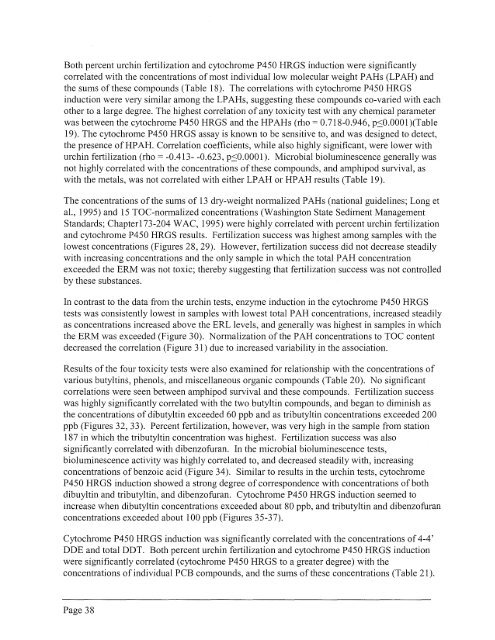Sediment Quality in Puget Sound Year 2 - Center for Coastal ...
Sediment Quality in Puget Sound Year 2 - Center for Coastal ...
Sediment Quality in Puget Sound Year 2 - Center for Coastal ...
You also want an ePaper? Increase the reach of your titles
YUMPU automatically turns print PDFs into web optimized ePapers that Google loves.
Both percent urch<strong>in</strong> fertilization and cytochrome P450 HRGS <strong>in</strong>duction were significantly<br />
correlated with the concentrations of most <strong>in</strong>dividual low molecular weight PAHs (LPAH) and<br />
the sums of these compounds (Table 18). The correlations with cytochrome P450 HRGS<br />
<strong>in</strong>duction were very similar among the LPAHs, suggest<strong>in</strong>g these compounds co-varied with each<br />
other to a large degree. The highest correlation of any toxicity test with any chemical parameter<br />
was between the cytochrome P450 HRGS and the HPAHs (rho = 0.718-0.946, pg.OOOl)(Table<br />
19). The cytochrome P450 HRGS assay is known to be sensitive to, and was designed to detect,<br />
the presence of HPAH. Correlation coefficients, while also highly significant, were lower with<br />
urch<strong>in</strong> fertilization (rho = -0.413- -0.623, pg.0001). Microbial biolum<strong>in</strong>escence generally was<br />
not highly correlated with the concentrations of these compounds, and amphipod survival, as<br />
with the metals, was not correlated with either LPAH or HPAH results (Table 19).<br />
The concentrations of the sums of 13 dry-weight normalized PAHs (national guidel<strong>in</strong>es; Long et<br />
al., 1995) and 15 TOC-normalized concentrations (Wash<strong>in</strong>gton State <strong>Sediment</strong> Management<br />
Standards; Chapter1 73-204 WAC, 1995) were highly correlated with percent urch<strong>in</strong> fertilization<br />
and cytochrome P450 HRGS results. Fertilization success was highest among samples with the<br />
lowest concentrations (Figures 28,29). However, fertilization success did not decrease steadily<br />
with <strong>in</strong>creas<strong>in</strong>g concentrations and the only sample <strong>in</strong> which the total PAH concentration<br />
exceeded the ERM was not toxic; thereby suggest<strong>in</strong>g that fertilization success was not controlled<br />
by these substances.<br />
In contrast to the data from the urch<strong>in</strong> tests, enzyme <strong>in</strong>duction <strong>in</strong> the cytochrome P450 HRGS<br />
tests was consistently lowest <strong>in</strong> samples with lowest total PAH concentrations, <strong>in</strong>creased steadily<br />
as concentrations <strong>in</strong>creased above the ERL levels, and generally was highest <strong>in</strong> samples <strong>in</strong> which<br />
the ERM was exceeded (Figure 30). Normalization of the PAH concentrations to TOC content<br />
decreased the correlation (Figure 3 1) due to <strong>in</strong>creased variability <strong>in</strong> the association.<br />
Results of the four toxicity tests were also exam<strong>in</strong>ed <strong>for</strong> relationship with the concentrations of<br />
various butylt<strong>in</strong>s, phenols, and miscellaneous organic compounds (Table 20). No significant<br />
correlations were seen between amphipod survival and these compounds. Fertilization success<br />
was highly significantly correlated with the two butylt<strong>in</strong> compounds, and began to dim<strong>in</strong>ish as<br />
the concentrations of dibutylt<strong>in</strong> exceeded 60 ppb and as tributylt<strong>in</strong> concentrations exceeded 200<br />
ppb (Figures 32,33). Percent fertilization, however, was very high <strong>in</strong> the sample from station<br />
187 <strong>in</strong> which the tributylt<strong>in</strong> concentration was highest. Fertilization success was also<br />
significantly correlated with dibenzofuran. In the microbial biolum<strong>in</strong>escence tests,<br />
biolum<strong>in</strong>escence activity was highly correlated to, and decreased steadily with, <strong>in</strong>creas<strong>in</strong>g<br />
concentrations of benzoic acid (Figure 34). Similar to results <strong>in</strong> the urch<strong>in</strong> tests, cytochrome<br />
P450 HRGS <strong>in</strong>duction showed a strong degree of correspondence with concentrations of both<br />
dibuylt<strong>in</strong> and tributylt<strong>in</strong>, and dibenzofuran. Cytochrome P450 HRGS <strong>in</strong>duction seemed to<br />
<strong>in</strong>crease when dibutylt<strong>in</strong> concentrations exceeded about 80 ppb, and tributylt<strong>in</strong> and dibenzofuran<br />
concentrations exceeded about 100 ppb (Figures 35-37).<br />
Cytochrome P450 HRGS <strong>in</strong>duction was significantly correlated with the concentrations of 4-4'<br />
DDE and total DDT. Both percent urch<strong>in</strong> fertilization and cytochrome P450 HRGS <strong>in</strong>duction<br />
were significantly correlated (cytochrome P450 HRGS to a greater degree) with the<br />
concentrations of <strong>in</strong>dividual PCB compounds, and the sums of these concentrations (Table 2 1).<br />
Page 38







